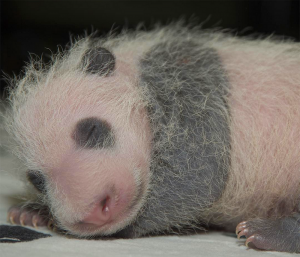
The panda cub has yet to be named, but will be bestowed one and presented to the public in January, contingent on health.
The panda cub at the National Zoo, who celebrates his one-month birthday today, has grown to more than two pounds and is in good health, on track to be named and revealed to the public in January.
The baby panda was born with a twin Aug. 22. However, the twin, born with respiratory problems, died five days after its birth, despite attempts by handlers to save it. The official cause of death has yet to be determined by the National Zoo.
Pandas are an endangered species, the rarest in the bear family, with only around 1,800 left in the wild.
The surviving cub is slightly over one kilogram, according to a weighing last Thursday.
“He is doing great,” Nicole MacCorkle, a giant panda keeper at the National Zoo, said. “That’s actually a little bit larger than expected, which is a good thing.”
The cub has begun to grow fur, and typical panda markings have started to appear. According to zoo officials, he already exhibits traits resembling both his mother, Mei Xiang, and father, Tian Tian. The next stage in the baby’s development will be the opening of his eyes and ears, which is expected in less than a month’s time.
“He is [growing hair] and his markings are coming in fairly clearly now so he now looks like a little panda,” MacCorkle said. “Things are going to progress pretty quickly.”
At the moment, the baby is trying to push upward with his front legs to get his weight underneath his body, which will allow him to walk.
After the cub begins to become more independent, Mei Xiang will leave the den for more extended periods of time to ease herself back into her old schedule.
“They’re very different creatures, but the mother has to get her schedule in sync with the baby,” MacCorkle said. “Once they’re on more of a routine, she’ll be able to go out of the den for longer periods of time to consume more bamboo because her appetite’s starting to come back.”
The decision to begin showing the pandas to the public will be made by the National Zoo management along with input from keepers, according to MacCorkle. She estimated that showings would not begin until December at the earliest, and would begin in phases, so as to not upset the baby panda.
“This is a busy exhibit in the zoo,” MacCorkle said. “We don’t want to go from having the whole building being quiet to just everybody trying to come in and see this little guy. We’ll ease [him] in.”
MacCorkle said the panda house has become more popular for tourists following the excitement around the baby panda’s birth and subsequent growth. She noted that at the time of the cub’s birth, his older sister Bao Bao was celebrating her second birthday, which also increased attendance.
“There’s always a lot of excitement around [the] panda house, even when there are just adults,” MacCorkle said. “It’s always a busy, bustling place, and even more so with a new cub. … There are a lot of people who are anxious for him to be on exhibit.”
Kate Cole (MSB ’18), president of Animalia, a student group dedicated to ensuring the humane treatment of animals, said that the announcement of the panda’s birth was very exciting, given the difficulties pandas often experience in having children. She said she hopes the baby will inspire the public to learn more about giant pandas.
“I was watching the news and they said they were born and I was very excited,” Cole said. “I know that this is a rarity, a real miracle. Whenever they announce that it will be open, [we] will be going. I’ll plan a trip for Animalia.”
MacCorkie said that visitors can visit the baby at the National Zoo until 2019, when due to an agreement with the Chinese government, the panda will be sent back to participate in a breeding program to help preserve the giant panda species.
“It is sad to see them go to China,” MacCorkle said. “But their big role is to get to save the species. That’s what they get to do, that’s their contribution.”
The Georgetown International Relations Club could not be reached for comment about panda diplomacy.
Maureen Berry (NHS ’18) said that the news of the panda’s birth has made her want to visit the National Zoo, even though she has not kept up to date with the pandas.
“I haven’t followed [news] about the pandas,” Berry said. “But, yeah, I’ll visit the zoo. Who doesn’t love pandas?”




















